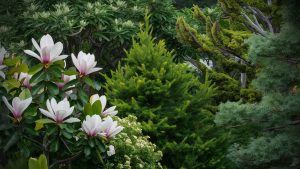Are you looking for a way to elevate your indoor gardening aesthetic without breaking the bank? A DIY plant stand can be a perfect solution, offering both functionality and style. In this guide, we’ll explore creating a unique plant stand using inexpensive materials, so you can beautify your space affordably.
Materials You’ll Need
To embark on this plant stand DIY project, gather the following materials:
1. Wood Pieces
Chunky Wood Sticks: These are great for creating a sturdy base for your plant stand. You can find them in the craft section. Depending on your design, you’ll want at least a few pieces of varying lengths.
Wood Planks: A wood plank can act as the top surface of your stand. Choose one that matches your design aesthetic.
2. Wood Glue
Wood glue is essential in assembling your plant stand. A strong adhesive ensures that your pieces stay together securely. It’s easy to use and dries clear, making it a perfect option for visible seams.
3. Hot Glue Gun and Glue Sticks
A hot glue gun provides a quick-drying adhesive option to hold your materials in place temporarily while the wood glue sets. It’s especially useful for adding decorative elements or attaching lighter pieces.
4. Espresso Wood Stain or Paint
For that chic, finished look, apply a dark wood stain like espresso. It enhances the natural beauty of the wood while providing a rich, polished appearance. Alternatively, if you prefer color, choose an acrylic paint of your liking.
5. Felt Pads
To protect your floors and reduce sliding, felt pads are perfect for placing on the bottom of each stand leg. Look for these in the furniture section of Dollar Tree or any hardware store.
6. Decorative Elements
Plastic Baskets:
These can be attached to the top of your plant stand to hold pots or additional decor items. Choose colors and styles that complement your chosen stain or paint.
Jute Cord or Ribbon:
Wrapping jute cord around specific parts of your stand can add a rustic touch. Ribbons can be used for an elegant or playful finish.
7. Screws (Optional)
If you want extra stability, adding screws can reinforce the structure, especially for larger plants. You’ll need a small power drill for this.
8. Paint Brushes and Rags
These will be necessary for applying your stain or paint evenly. Rags can be used to wipe away any excess stain and for drying your assembled pieces.
9. Saucers and Plates
Consider adding saucers to serve as a base or an additional level for your plants. These plates can accommodate drainage and help you maintain a clean surface.
Step-by-Step Instructions
Now that you have your materials, let’s dive into the step-by-step process of creating your DIY plant stand.
Step 1: Preparing Your Wood
Start by sanding any rough edges on your wood pieces. Use fine-grit sandpaper to ensure a smooth finish that won’t snag any fabric or skin. After sanding, wipe the pieces down with a damp rag to remove any dust.
Step 2: Staining or Painting the Wood
Using your paintbrush, apply the espresso wood stain or paint to all visible surfaces of the wood pieces. A few light coats will give you the best coverage without drips. If you choose to stain, allow it to dry completely before moving forward with assembly. You can use rags to wipe off excess stain if you prefer a lighter finish.
Step 3: Assembling the Base
Begin by attaching your chunky wood sticks to form the legs of your plant stand. For maximum stability, use both wood glue and hot glue. Apply the wood glue to the bottom ends of the sticks and attach them to the corners of the wood plank intended as the top. Ensure the sticks are perpendicular to the plank for a sturdy base.
Step 4: Adding Felt Pads
Once your legs are attached securely and the glue has set, turn the stand upside down. Attach felt pads to the bottom of each stick. This will protect your floors from scratches and keep the plant stand from sliding around.
Step 5: Attaching the Decorative Basket
If you want to add a decorative basket, first spray paint it in your desired color to complement your DIY stand. After the paint has dried, use wood glue or hot glue to attach the basket to the top of the stand. Ensure it’s centered and give it some time to set. This added basket will not only serve as a stylish spot for your plants but can also be a beautiful decor piece on its own.
Step 6: Final Touches with Decorative Elements
To take your plant stand to the next level, consider wrapping jute cord or ribbon around the legs where they meet the top or the middle sections of the legs. This detail adds texture and can enhance the overall aesthetic. Secure the end of the jute cord or ribbon with hot glue, and trim any excess.
If you’re considering adding a second level using saucers or plates, you can glue these to the sides of the stand for enhanced utility. For drainage, make sure any saucers used for your plants have holes to allow water to escape.
Step 7: Ensuring Stability with Screws (Optional)
If your stand feels a little wobbly, particularly if you plan on using heavier pots, you can reinforce it with screws. Calculate where you want to place screws on the legs where they attach to the top surface. Use a power drill to create pilot holes before inserting screws, as this will prevent the wood from splitting.
Step 8: Finishing Touches
After everything is glued and secured, give your plant stand a final inspection. Check for any visible glue that may need to be wiped away, or additional paint needed for touch-ups. Once satisfied, allow everything to set undisturbed for a few hours to ensure the integrity of your structure.
Step 9: Styling Your Plant Stand
Now it’s time to style your newly created plant stand! Choose a variety of plants of differing heights and place them in your attached basket and any saucers or plates you have positioned on the stand. Consider arranging the plants in a visually appealing manner—taller plants behind shorter ones often provide an eye-catching look.
Feel free to mix in decorative items like rocks, colored stones, or even small figurines to add personality to your plant stand. This way, the stand becomes not just functional but a true centerpiece in your home.
Maintenance and Care for Your DIY Plant Stand
Cleaning
Over time, your DIY plant stand may accumulate dust or dirt. Use a soft, damp cloth to wipe it down regularly, being mindful not to soak the wood, especially if it’s stained. If you used paint, consider touch-up paints for any areas that may need it occasionally.
Plant Care
Ensure that the plants you choose for your stand have appropriate needs regarding sunlight and watering. Position the stand near a light source if necessary, and remember to check the water levels according to the specific requirements of each plant.
Reassessing Stability
If then you notice any wobbling or instability after some time, reassess the joints and glue points. Reinforce them with more wood glue or screws if needed to ensure that your plant stand remains sturdy.
Conclusion
Creating your own plant stand using inexpensive materials is not only an enjoyable DIY project but also a fantastic way to beautify your living space affordably. With just a little creativity, you can craft a functional and stunning piece that showcases your love of plants.
This step-by-step guide provides everything you need to know to create your DIY plant stand, and the best part is that you can customize it to fit your unique style and home decor. So why wait? Gather your materials, get crafting, and enjoy your very own stylish plant stand that brings a touch of nature indoors!
Feel free to share your creations or any tips you have for crafting your own plant stand. We’d love to hear how your project turned out!















